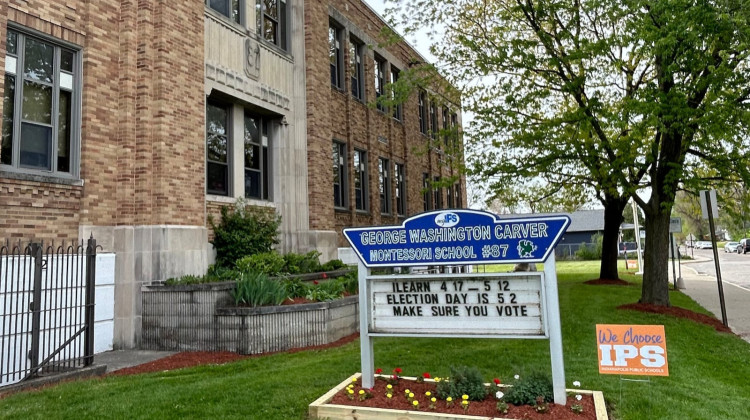
Kewanna Heard, a mother of seven, helps her children pick out shoes while at a back-to-school event in Indianapolis offering free school clothes and supplies.
Elizabeth Gabriel/WFYI NewsHundreds of families recently withstood the sweltering July heat to stand in line at a free school supplies event in Haughville, a neighborhood on the Near Westside of Indianapolis. It was nearly double the number of families compared to last year who showed up to the Christamore House community center. Parents said the surge in inflation makes it harder for them to afford back-to-school items.
“The price of everything went up — gas, food prices — everything just went up high,” said Kewanna Heard, a mother of seven children. “And your job is not paying you as much to sustain your living. So it's been real hard.”
Across all consumer products, including those Heard was concerned about, the latest inflation rate was about 9 percent. Even though some Hoosier wages have increased by roughly 4 to 7 percent — depending on the industry and the particular job — it isn’t enough to keep up with the year-to-year price increases the country hasn’t seen for almost 40 years, said R. Andrew Butters, an assistant professor of business economics and public policy at Indiana University.
The labor market is strong, Butters said, and some households have increased income, but it's not enough.
"Those gains are still probably unlikely to fully compensate the households for the increase in costs," he said.
Last school year there was a record-breaking increase in back-to-school spending because people were buying more items as students returned to in-person learning following the height of the pandemic.
This year, families are expected to spend even more – $864 on back-to-school items, roughly $15 more than last year, according to the National Retail Federation.
But this year the spending increase is due to everything – including school supplies – being more expensive. Butters said families on average are spending roughly 10 percent more on overall living expenses than they did in previous years.
The latest Consumer Price Index results showed the most significant inflation increases have come from energy components, such as household utility bills and gas for vehicles, as well as groceries. That leaves less money to spend on students’ needs, like new clothes, notebooks, calculators and general classroom supplies some teachers request.
“If you have to choose between getting your kid crayons and putting food on the table, you're definitely going to pick the food on the table,” said La’Toya Pitts, chief executive director of the Christamore House.
Although the economic status varies for Haughville residents, the area is home to many low-to-zero-income families. Pitts said roughly 95 percent of the population that they serve are Black and Brown families. The center typically hosts supply drives once or twice a year with a projected turnout of 200 to 250 families per event.
The Haughville native said the surge in prices is affecting everybody. Families who have never struggled to provide for their children are now asking for support, from gift cards to grocery stores to bus passes or other transportation needs. But the gap between families who already lacked access to resources is even bigger.
Inflation causes strain for donation drive organizers
The Christamore House’s supply drive was organized by four high school students participating in an eight-week internship sponsored by the Bank of America Student Leaders program. The Rushville-based organization Changing Footprints, which has several Indianapolis offices, donated 700 pairs of shoes. The Black Employee Network and an anonymous pastor also donated supplies. The Christamore House used roughly $2,500 to purchase about 300 school uniforms that were distributed for free.
Even with the community support, student organizers said more is needed to help local families. When shopping for supplies, they found their dollars didn’t stretch as far as they used to.
“For instance, $200 doesn't go a lot towards backpacks anymore,” said Nik, a summer intern and a senior at Park Tudor High School. “That's 10 backpacks. When we're trying to serve 500 people that's just not something we can afford as a local nonprofit.”
Heard, the mother of seven, arrived late and missed out on the free uniforms and some of the school supplies. Now she’s trying to find other places that will provide free school clothes so she doesn’t have to rack up her credit card debt.
“We had to stop going to unnecessary places,” Heard said. “So we do everything in our house now. We've cut back on certain things like the stuff they used to eat, like name brand foods. We've been switching them out for the non-name brand foods. Everything is limited right now.”
Indiana lawmakers are debating in a special legislative session how to best help Hoosiers struggling with inflation-related costs. But some of the energy price increases are largely out of the control of state legislators until international relationships, such as the war in Ukraine, are under control.
Butters, the IU assistant professor, hopes to see lower inflation rates by the end of the year as the Federal Reserve works to combat inflation, families return to the labor market and supply chain issues decrease.
Contact WFYI education reporter Elizabeth Gabriel at egabriel@wfyi.org. Follow on Twitter: @_elizabethgabs.
 DONATE
DONATE






 Support WFYI. We can't do it without you.
Support WFYI. We can't do it without you.